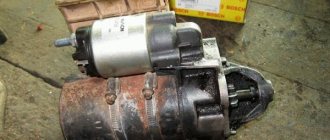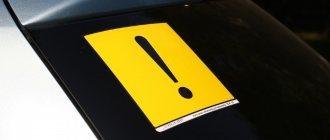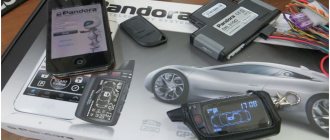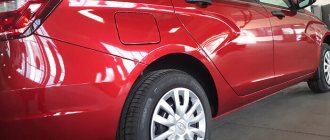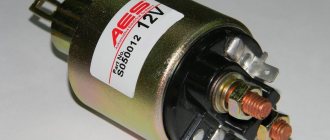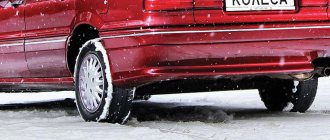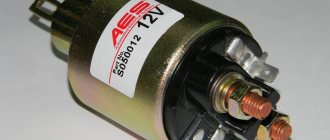Many motorists have at least once found themselves in a situation where a car starter stubbornly refused to fulfill its main purpose. And everything would not be so sad, but such situations always happen at the most unexpected and inopportune moment. If you need to go immediately, but time is running out, this can become a real problem and a reason for a breakdown. Fortunately, there is a way out of this situation. You just need to start the vehicle without a starter or close it directly. How to do both will be discussed in more detail within the framework of this useful material.
There are nuances
First, a little theory. How does the starter start the engine? Through engagement with the flywheel, the crankshaft rotates - this is how the launch occurs. If the starter cannot do its job for one reason or another (it is broken or the battery is discharged), then you can turn the crankshaft in another way - by rotating the drive wheels. The most well-known method is “from the pusher,” that is, by accelerating the car and then engaging the appropriate gear. In this case, the connection between the wheels and the engine will ensure that the crankshaft turns at a speed sufficient for starting. But there are nuances.
First of all, this method is suitable for cars with a manual transmission. An “automatic” with a torque converter, due to its design features, simply will not allow the transmission of torque to the crankshaft from the wheels. Other types of automatic transmissions, for example, robotic, with a clutch? Here you need to look at their features, but in any case it’s not worth it, so as not to harm the transmission.
As a matter of fact, even with a “mechanics”, starting “from a pusher” can have its consequences, although not for the box (the likelihood of damaging it is minimal), but for the engine. If the timing chain drive is with a hydraulic tensioner, there is a risk of the chain jumping when trying to start in this way. It is more reliable with a belt, but in severe frost it may not withstand the shock load. And in general, you need to understand that this method of starting the engine is an emergency. An old primitive unit is no stranger to this, but a modern one can then accumulate various errors into the control unit. In addition, such a start, albeit theoretically, is fraught with damage to the catalyst. So weigh the risks, as they say.
One more thing. Push start means driving the car with the engine initially turned off, that is, with the power steering and brakes not working. In this case, you should also perform non-standard manipulations with the gearbox and clutch, which, for example, can cause problems for a beginner. Plus, when the gear is engaged and the clutch is released, the drive wheels brake sharply - on a slippery surface this can lead to a loss of directional stability (for example, a rear-wheel drive car can start to skid). All this must be taken into account so that an attempt to start the engine in this way does not lead to an accident. This is about choosing a place, speed and moment.
Starting an engine without a starter with an automatic transmission using the short-circuit method
To properly start the engine by closing the starter on cars with an automatic transmission, it is necessary to take into account the electrical diagram of the connections of its components. A typical mistake made by motorists when trying to close the starter is to bridge the two output terminals of the contacts with a screwdriver. In this case, the electric motor is activated, but the traction relay remains disconnected and the overrunning clutch is not connected. It is not recommended to directly close the starter power terminals.
Any starter has three positive contacts “B”, “M”, “S” and one negative - 8, which is always connected to the housing. Terminal "B" is always under DC voltage from the battery. Procedure:
- Before closing the contacts, you need to find the “S” terminal. On modern starters it looks like a protective casing-petal.
- Carefully observe the difference between contacts “B” and “M” - the permanently connected “B” is marked “+12”.
- To start the starter, contact “B” and terminal “S” are closed.
- The short circuit occurs briefly and only after connecting the “neutral”.
- It is forbidden to close contacts “B” and “M”!
On domestically produced cars, it is easy to find the necessary starter terminals: for example, a traction relay with contact designations on a VAZ 2114 looks like this:
Output contact “B” here is covered with a rubber protective casing, and the traction relay terminal “S” is located under a plastic plug, which must be removed before closing.
The contact is closed with a screwdriver when the ignition is connected:
Important: when closing, make sure that the screwdriver does not touch the body of the solenoid relay, otherwise “+” and “ground” will be shorted!
On foreign cars with automatic transmission, the “S” terminal looks different: it is often made in the form of a threaded terminal with a copper tip and white wire insulation. It is convenient to close such a contact with an open-end wrench:
When closing contacts, observe safety precautions: the traction relay of a car at idle speed consumes from 30 to 100 A, and the starting current can reach up to 600 A. You must work with insulating gloves; if the screwdriver or key “sticks”, you should immediately remove the minus terminal from battery. The 12 V starter operating voltage is not dangerous, but errors can burn fuses or wiring.
Read also: Error 0134 Dodge Caravan
I pushed it myself - I started it myself
Anyone who has driven with a weak battery knows: you need to leave the car on a hill, from which you can roll down and start it “from the pusher”. But is a very low speed enough if the road has almost no slope and you accelerate the car yourself?
The operating principle is as follows: turn on the ignition, put the transmission in neutral, manually accelerate the car, jump in, squeeze the clutch, engage the gear, release the clutch...
On a very flat section, the speed is still not enough. You can, of course, try to overclock it - the machine is light. I'm strong - can I handle it? I'm smart: there's still an easy descent ahead. For the purity of the experiment, I simply won’t accelerate the car too much, I’ll try at minimum speed.
It doesn't work in second gear - it's too slow. Well, then the first one - and the car starts. I do the same trick in reverse gear, rolling the car back. This is about the fact that you can push in any direction depending on where the descent goes.
As experience shows, not every car can start like that, with half a turn - it all depends on the design features and the condition of the engine. And even more so, this applies to cases when, in the same winter, the engine is, in principle, reluctant to start. And in this case, you cannot do without the help of a friend. Or is it still possible?
Advantages
Rarely and only in some workshops there is a service for replacing absolutely any starter model. One of such campaigns is auto repair shops at their service, several specialized wholesale warehouses in Lyubertsy, Zheleznodorozhny and Moscow.
If necessary, having encountered a malfunction of a rare starter of a foreign passenger car or special equipment, the client can contact the auto repair shop and order starter repair.
guarantees the completion of any most complex repairs.
Source
All in your hands
You can try an exotic method in which the car remains in place and the suspended wheel spins. To do this, the car is raised on a jack, a rope or cable is wound around the wheel - the pulling movement is converted into a rotational movement, and it is transmitted to the crankshaft. Why such difficulties? If there is only one driver, conditions do not always allow you to push the car and accelerate it to the required speed in order to start the engine “from the pusher”. Here you can do it yourself.
But even in this case, you need to remember about safety precautions. If we put the car on a jack, do not forget to use the parking brake, and ideally put chocks under the remaining wheels. It should be taken into account that during the starting process the car may jump off the jack. If the engine starts at this moment, the car will start moving. The likelihood of this is especially high in the case of an all-wheel drive transmission and the presence of working locks. But if you have a single-wheel drive, a free differential, then there are no problems: the suspended wheel can be rotated, the second one will calmly stand on the ground without attempting to move.
But enough theory, let's check it in practice! We use a brand new cable especially for the experiment. It does not have metal hooks, which is also important: a hook or even just a tight knot can cause trouble in the arch when the wheel spins.
So, we put the car on a jack, tighten the handbrake, turn on the ignition, and first we’ll try to leave the gearbox in third gear. Here the relationship is as follows: the higher the gear, the easier it will be to spin the wheel, but the higher its rotation speed must be for the engine to “grab.” First attempt, second... Still not enough speed. Switching the box to the second...
It turned out to be surprisingly easy! Indeed, the engine started instantly, the car did not even make an attempt to escape. The method works! However, as far as we know, it does not always work. Much depends on technology. But in our case it worked.
What must be done before closing the starter?
Few people know, but before taking more drastic measures, motorists must perform diagnostics. For what? It would be a good idea to understand, before performing any work, what is causing the failure of the starter and what could be wrong with it. Sometimes problems with the starter can be fixed on the spot yourself. However, if serious problems arise with the starter, such as a malfunction of its relay or a breakdown of the solenoid relay, severe wear of the bendix or a burnt winding, then you can immediately begin to look for a way to start the car engine using another method. And although there are not many such methods for starting a motor with a non-working starter, they still work and without fail.
Hey, in tow!
As you can see, you can start the engine even alone. Yet these methods are not always available. Then the classic is launch from a tug. It is almost inevitable if the engine is difficult to start, that is, the problem is not in the battery or starter, but, for example, in the fuel system, ignition or a faulty crankshaft sensor.
We won’t check anything here – everything is clear. Therefore, we will give some tips for those who are not experienced in towing, and especially in using this method of starting the engine.
If the towing eye is screw-in, it is important to screw it in completely, otherwise there is a risk of breaking it off at the thread. If you don’t have enough hand strength, you can use a lever - you can use a wheel wrench for this purpose.
It will also come in handy if your cable ends in a loop at the end rather than a hook. Just pull it through the eye and insert the same wheel wrench. Or carob. At the same time, it is important to make sure that this “stopper” does not dangle and does not touch the body. If this happens, you can make a knot in the cable and insert the key so as to avoid its contact with the car.
We talked in some detail about the rules and features of towing, but now we are interested in trying to start the engine. At the same time, it is also important to maintain tension on the cable in order to avoid jerking or running over the cable. Success depends on the coordinated actions of both drivers. The one who is on the tractor must show all his maneuvers in advance; the one who is in tow must remember that the power steering and brakes may not work. The driver of the leading car only indicates the need for braking, in extreme cases he helps, and the driver of the driven car brakes the entire train - this ensures the tension of the cable.
Now regarding the attempt to start the engine. It is best to do it on a straight section of a flat road, ideally with a good grip, but in winter this is not always possible. The correct choice of gear is important: it is better to proceed from the consideration that it should ensure engine operation in the range of 1000-2000 rpm. When engaging a gear, the clutch needs to work smoothly - and you should be prepared for the fact that on a slippery road at this moment the car may lead due to a sharp change in the speed of rotation of the wheels.
It is not always possible to start the engine even after several attempts. In some situations (for example, with flooded spark plugs), constant movement in the engaged gear for a long time can be used, similar to the cold run-in mode. In this case, the highest gear is selected with a short-term (when stopping at a traffic light, starting and accelerating) transition to neutral. It is worth considering that when the ignition is on, powerful consumers of electricity can be used (headlights, heaters, audio system), so it is better to turn them off while trying to start the engine.
After a successful start, if the engine is running unstable, it makes sense to drive in gear for some time with the help of a tow, since squeezing the clutch or trying to release the gas can lead to the engine stalling. Well, agree in advance with the tug driver how you will indicate a successful attempt. However, by default this is a short-term sound signal and a short-term turning on of the headlights. If the horn does not work and the driver does not respond to the sound alarm, you can draw his attention by smoothly braking the entire road train.
Starters in the Autobusiness spare parts database
Other reasons why the car won't start
The role of the starter in the engine is to spin the crankshaft. It creates the necessary torque and compresses the mixture of fuel and air.
Due to the fact that the starting device does not act alone, but in conjunction with other components and assemblies, the following factors may be the source of problems:
- insufficient voltage in the battery;
- complete loss of battery charge;
- destruction of wiring or contacts;
- the appearance of malfunctions in the ignition switch;
- oil with non-standard characteristics;
- atmospheric corrosion of some parts of the conductive circuit.
A handy alternative to a traction relay
If you close the starter terminals, you will be able to direct the current directly to the electrical windings. In this case, a screwdriver or other improvised device will perform the function of a traction relay.
It is very important to put the car on the handbrake and at neutral speed before carrying out such manipulations, otherwise severe injury or death of the mechanic is likely due to the vehicle getting out of control.
Types of automatic transmissions
At the moment, there are three types of automatic transmissions:
- Automatic hydraulic box. It completely separates the engine and wheels. They are not directly connected to each other, but the torque is transmitted through turbines through a special fluid. Modern boxes are additionally equipped with electronic devices that allow you to set different operating modes. It is also possible to simulate manual gear shifting, although it will be generally controlled by the automatic transmission;
- Robotic mechanics. This gearbox is not very popular among drivers. It is mainly adapted for a calm and smooth ride, but it is much more difficult to cope with acceleration. In terms of the type of control, this is an ordinary automatic machine that has nothing to do with mechanics. A regular robot is equipped with one clutch, which is not enough for smooth gear changes. There is often a feeling of a “thrown clutch” when accelerating. The car seems to be frantically jumping through the gears and does not have time to work through them to the end, which is why slight “jabs” occur. Recently, a robot with two clutches has been developed (for example, DSG for Volkswagen and DCT for BMW). Here things are much better and the car copes with acceleration, but the service life of such a transmission is so unpredictable and often short that there is even an official petition of many thousands from the owners of such “experiments” demanding a free DSG replacement even after the warranty expires. Moreover, in Europe, a similar complaint was considered and fulfilled, agreeing with the imperfection of the automatic transmission, but in Russia, manufacturers are not yet in a hurry to admit the low reliability of the robot;
- CVT (continuously variable transmission, CVT). In essence, these are the same hydraulics, only without fixed gears. A car with this automatic transmission will move smoothly, without changing the sound of the engine, and gradually increase the speed, without losing it due to gear changes, as in the hydraulic version. This is an economical option in terms of fuel, but the working life is short and the main components of the box may need to be replaced before reaching 200 thousand kilometers.
This is interesting: Wheels for Renault Duster: choice, size, bolt pattern
Method two - towing
No less efficient and even more reliable, but you need another machine more powerful than your car. It will be enough to tow the vehicle for a short distance, and then start the engine in the same manner as described above. In this case, I would like to give a couple of practical tips:
- Do not turn off the car after it has started and then go straight to the service center;
- Do not forget that after starting the car, it will pick up speed if it is in second gear and you press the accelerator pedal;
- Don’t forget that after starting, the car towing you will stop. Therefore, you will need to have time to slow down.
Each of the listed options can be used to get to your home or service station. It is highly not recommended to use them every day.
Danger of screwdriver sticking to starter terminals
You should also be prepared for another extremely unpleasant scenario. At the points where the iron rod comes into contact with the terminals, no matter what the current strength in the vehicle network, a current of up to fifty amperes is created.
For this reason, the screwdriver pin is quite capable of both sticking to the contacts and striking sharply into the palm. In such a case, it is necessary to reset the negative terminal using an open-end wrench without unnecessary emotions.
